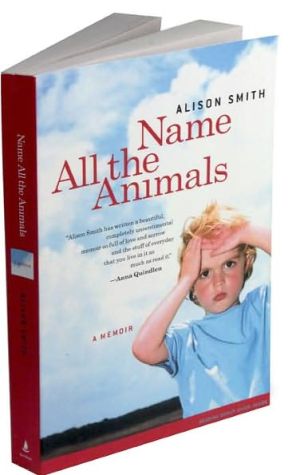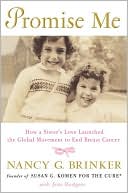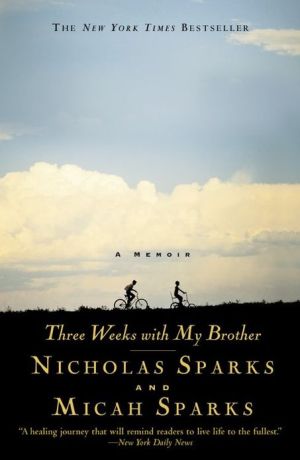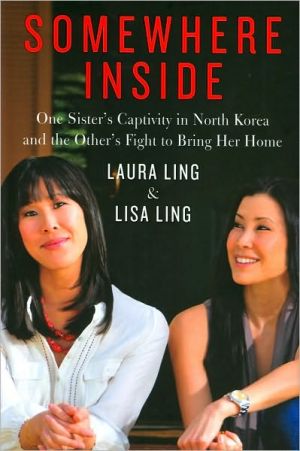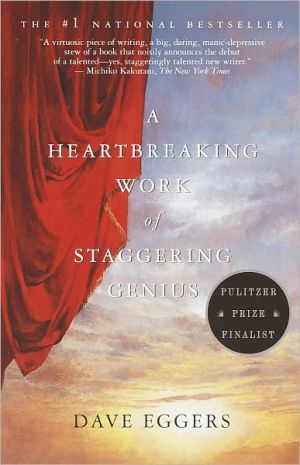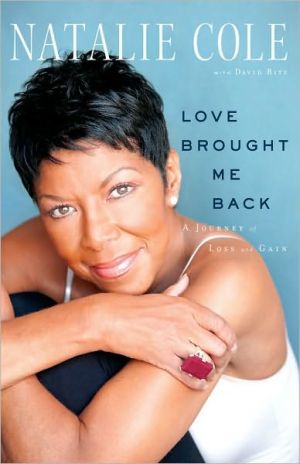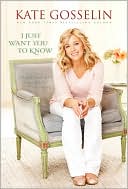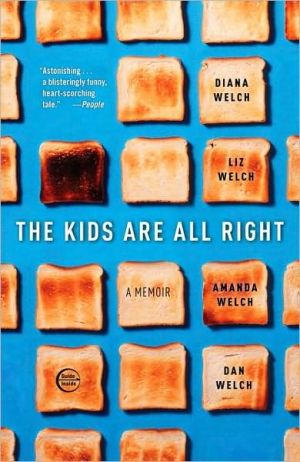Name All the Animals: A Memoir
A luminous, true story, Name All the Animals is an unparalleled account of grief and secret love: the tale of a family clinging to the memory of a lost child, and of a young woman struggling to define herself in the wake of his loss. As children, siblings Alison and Roy Smith were so close that their mother called them by one name, Alroy. But when Alison was fifteen, she woke one day to learn that Roy, eighteen, was dead.\ Heartbreaking but hopeful, this extraordinary memoir explores the...
Search in google:
"As children, siblings Alison and Roy Smith were so close that their mother called them by one name: Alroy. But on a cool summer morning when Alison was fifteen, she work to learn that Roy, eighteen, was dead. This is Smith's extraordinary account of the impact of that loss - on herself, on her parents, and on a deeply religious community." At home, Alison and her parents sleepwalk in shifts. Alison hoards food for her lost brother, hides in the backyard fort they built together, and waits for him to return. During the day, she breaks every rule at Our Lady of Mercy School for Girls, where the baffled but loving nuns offer prayer, Shakespeare, and a job running the switchboard. In the end, Alison finds her own way to survive: a startling and taboo first love that helps her discover a world beyond the death of her brother. The New York Times Roy remains real throughout the book, invoked at well-chosen intervals through memory and through his sister's acts of devotion. (She saves food for him. She regards even his worn-out running shoes with tenderness and reverence.) And the idea of punishment for her transgressions is equally substantial, giving the reader a sense of how much was at stake for her as she tried to regain her bearings. "Hell was a real place for us, as real as the next neighborhood," she writes. "In our insular Catholic world, hell practically had its own ZIP code." — Janet Maslin
Chapter One\ I started skating at nearly the same time I took my first steps. Mother taught me how on the outdoor rink at the local park. Every weekend she took me there and we skated in circles the wobbly gait of the swamp-skater, pushing off with the serrated tip. The spring after I turned fifteen, the ice melted as it did every April, and still I showed up, like clockwork, my skates slung over my shoulder. I watched the ice dissolve back into Allen's Creek. Mother drove down and met me, popped open the passenger-side door of the family camper-van, and said, "Hop in. I've got a surprise for you." That day I skated on an indoor rink for the first time. There was something in the long mile of that white room, in the coolness of the air and the smell of the ice — like the inside of a tin cup — and all the while outside I knew the sun was tapping on the roof, warming the tiles, begging to be let in. I was hooked. I joined the rink's figure skating academy.\ The girls at the Rochester Skating Academy in 1984 were a hardy bunch — great jumpers, who raced around the rink backwards at high speeds. I was the one in the corner by the sidewall pushing my wire-rim glasses up my nose, my stockings bunched at the knees. I did not jump. My spins were slow and careful. But I did have one thing going for me. I was good at Patch.\ Patch was named for the sectioning of the ice into six-by-eight-foot strips or patches. The first thing to do when you get to your assigned patch is carve two adjacent circles, using an instrument called a scribe (which looks like an overgrown compass). On that huge number eight you try to skate the perfect figure. It's harder than it looks — keeping the cut line of the blade arced, the skate moving at a good clip, never straying from the two circles. It was my favorite part of the day: the collective silence of concentration, drilling over and over a single blade turn, the subtle weight shifts, from front to back, right to left. This measured intricacy, the repetitive devotion it required — it was the closest you could get to praying on ice.\ In late July, three months after I started my indoor skating career, I had an accident during morning Patch Hour. While practicing the 180-degree turn in the center of the eight, I slipped and fell. Sixteen pairs of eyes looked up from their patches and stared at me. I tried to stand up. My leg warmers slid down over my heels. I moved to adjust them, and then I saw it. In the center of the eight, at the fulcrum of the north and south circles, lay a spot of blood. A darkening stain ran across the crotch of my skating dress. I crossed my legs.\ Moments later, in the bathroom at the Rochester Skating Rink, dark flowers of blood spread across the toilet water. I called Mother from a pay phone in the hall.\ "It's your first," she whispered into the phone. She was at the architecture firm where she worked as a secretary.\ "I've got blood all over me!"\ "All right. I'll meet you in the bathroom, the one by the soda machine."\ "Bring a bucket."\ "Oh stop," she said. "It's not that bad."\ I waited for Mother in the stall farthest from the door. When she entered, her low heels clip-clopped across the floor. She went straight for the last stall and opened the door. My skates were still on, the laces loosened. I had crammed half a roll of toilet paper between my legs. She slouched, one hand on her hip. "Alroy," she whispered as she shook her head. It's not my name. It's ours, my brother's and mine. A pet name she made up, combining Roy's name and mine into a single shorthand. "That bad, Alroy?" she asked.\ I nodded and gazed up at her.\ My mother stood in her homemade wraparound skirt with the blue flowers. She had tucked a white summer blouse into its ribboned waist. She wore her hair short, in a Dorothy Hamill cut, and in the humidity it curled out around her ears like wings. She slid her purse off her shoulder, pulled out a pack of extrathick sanitary pads, a bottle of pills, and a collapsible camping cup. She crossed over to the sink, filled the cup with water, and thrust both her hands under my nose. One held the cup, the other two pink pills.\ "Take these."\ I swallowed the pills. She ran her hand over my forehead. I pushed her away. She handed me a pad and backed up. Through the metal door I heard her sigh. She tapped her foot. I leaned back. The flusher jabbed me in the kidneys. I peeled the white adhesive strip off the back of the pad and slid my skating dress down.\ Mother drove me home. After she set me up in bed with a bottle of Midol and a copy of the Psalms, she made no proud speech about my initiation into womanhood, offered no advice on the prevention of menstrual cramps or the application of sanitary pads. She cleared her throat, ran her fingers through her hair, and said, "I'll tell Daddy. You tell Roy."\ And with that she left me and returned to work.\ When Roy showed up outside my bedroom door later that afternoon, he was holding a portable radio. He had just come from his morning job as a groundskeeper at a local country club and was already dressed for his second summer job as a cashier at Tops Supermarket. The stiff red uniform vest, boxy and oversized, hung on his narrow frame. Wrapping a leg around the door, he leaned into the room. "Hey, little sister, who's your superman? Hey, little sister, who's the one you want?" he crooned along with Billy Idol. Then he pulled back, hit his head against the doorframe, and tumbled to the ground, moaning in mock pain.\ "Roy-dee," I hollered, from under the covers.\ "Little Sister," he hollered back, pulling himself up.\ Billy Idol was not his music of choice. He was more a fan of the Police and the Who, but he knew this song drove me crazy. Whenever the local station played it, he rushed toward me, his arms out, singing at the top of his lungs.\ I yelled over the sound of the radio. "I'm sick!"\ "What?" he yelled back.\ I pointed at the radio. He turned it down.\ "I'm sick."\ He walked into the room. "How do I look?" Under the uniform vest he wore an orange Hawaiian shirt and maroon running pants.\ "Terrible. Everything clashes."\ "Good!" His head bobbed up and down. "It's your turn to do the dishes."\ "Will you do them?"\ He glanced over at me. "What's wrong with you?"\ "Nothing."\ His hands thrummed out a beat against the door. "I thought you said you were sick."\ I could feel the blood rushing to my head. My face grew hot. "I have my period."\ "Your what?"\ "My period!"\ The thrumming stopped. I could hear him breathing; his lungs were congested. "Oh," he said.\ He became engrossed in the pattern of his Hawaiian shirt. His hair was long; he had let it grow now that he was not in school. It ran over his ears and scrolled out around the base of his skull. The sun was shining in the window over the porch, and the evergreens' bright needles shimmered in the windless afternoon. He stepped into the room, picked up my skates, and started swinging them by the laces.\ "Don't touch those," I said. I reached across the bed, grabbed them from him, and shoved them under the blankets.\ He cleared his throat. "It's supposed to rain tonight," he said.\ "What do you want, Alroy?"\ "It's your turn to do the dishes."\ "You do them."\ "No, you."\ "No, you."\ "No, you."\ "Loser," I said.\ "Dweeb."\ "Mutant."\ "Moron!" And then he lost it. He broke into a grin. Paper white teeth, three dimples — one on either side and a little dent in his chin.\ "Alroy," I said.\ He disappeared behind the door again. He coughed once. The breath rattled in and out of him. He had just recovered from a nasty bout of bronchitis. One hand on the door, the other on the doorframe, he leaned back into the room and smiled. From my position on the bed I saw only half of him. A slice of brown hair, tan skin, and the hideous orange and red.\ Outside a mourning dove cooed. The sun beat down on us through the back window, no trace of the coming storm. It was four in the afternoon. I looked away. I felt a slip in the air, a nearly imperceptible change in temperature. I turned to catch him, but he had already left.\ I fell asleep, my hands wrapped around my skates. I slept straight through without eating supper, without going to my evening job at the Sisters of Mercy Convent. And as I slept a storm gathered over Lake Ontario, ten miles to the north. At one o'clock the sky broke open. Rain pelted the ground, rivered into the gullies along Penfield Road. It rained all night, and it was raining the next morning when Roy left for work. Friday, July 27, 1984. Father stopped him at the front door.\ "What are you going to do," Father asked, "in the rain?"\ Roy tossed the keys to the van from his right hand to his left and hitched up his shorts. "We'll wash the golf carts," he said.\ At 5:51 A.M. Father opened the front door for him. Roy ducked into the driving storm. He was gone. It was not for another two hours, when it was too late, that I would walk into the kitchen and see. He had done the dishes after all.\ Copyright © 2004 by Alison Smith
\ From Barnes & NobleBarnes & Noble Discover Great New Writers\ An intensely stirring coming-of-age memoir by Alison Smith, Name All the Animals brilliantly explores the power and limitations of a family's faith. Smith was 15 when her older brother, Roy, was killed in a car accident, and her memoir follows her family as they attempt to put their lives back together. Her parents try to take comfort in their strong Catholic faith but are nonetheless shattered. For her part, Smith wonders why God has abandoned her. She finds cold comfort in Catholic symbols and rituals, feeling a connection to Roy only when she enters the old fort they had built together. \ An engaging storyteller, Smith crafts her memoir to read like a novel, interspersing moving flashbacks of the times she spent with her brother with amusing portraits of the nuns at her parochial school, who sneak out of the infirmary to play cards and make autumnal visits to a secret swimming pool. As a child, Smith wonders why her father blesses her and Roy every morning, touching a relic to their foreheads, mouths, and hands, mentioning each individual body part. "He's got to name us, like Adam named the animals," Roy explained. "To keep track of them." The near impossibility of "keeping track," and the changing nature of faith are just two of the poignant messages in this unforgettable debut. (Winter/Spring 2004 Selection)\ \ \ \ \ \ The New York TimesRoy remains real throughout the book, invoked at well-chosen intervals through memory and through his sister's acts of devotion. (She saves food for him. She regards even his worn-out running shoes with tenderness and reverence.) And the idea of punishment for her transgressions is equally substantial, giving the reader a sense of how much was at stake for her as she tried to regain her bearings. "Hell was a real place for us, as real as the next neighborhood," she writes. "In our insular Catholic world, hell practically had its own ZIP code." — Janet Maslin\ \ \ Publishers WeeklyIn her first book, Smith, an alumna of the Yaddo and MacDowell writers' colonies, confidently weaves together aspects of a traditional coming-of-age memoir with a story of unimaginable loss. In lucid, controlled prose, she meticulously reconstructs her family's journey through the three years following her 18-year-old brother Roy's death in a car accident, just weeks before he was to start college, in 1984. Despite their overwhelming grief, Smith's devout Catholic parents' faith does not waver, but the 15-year-old Smith grapples with her beliefs. "I thought perhaps it was my fault that Roy had left us," she writes. "I thought I was being punished for some unknown sin." A student at a Rochester, N.Y., Catholic high school, Smith can't express her doubts, nor can she reveal her romantic feelings for one of her schoolmates, a less sheltered girl who introduces her to Colette and van Gogh. And even though Smith becomes exceedingly thin, her mother and father fail to notice she's anorexic. Name All the Animals (the title refers to Adam naming the animals in the Garden of Eden) includes many vivid images, although some of the language can seem too pretty and composed. The book closes with the third anniversary of Roy's death. "If I lived past the summer of my eighteenth year," Smith resolves, "I would have to face that Roy died and that I the little sister, the tagalong... would surpass him." It's a brave ending to an impressive debut. (Feb. 10) Copyright 2003 Reed Business Information.\ \ \ \ \ Library JournalThis compelling memoir recounts the effect on a teenager, and her family, when her beloved brother and companion dies. So close are the siblings that their parents call them by a combined nickname Alroy (for Alison and Roy). Their parents are devout Catholics, and they live in a close-knit neighborhood. Roy is heading for college, and Alison, at 15, is working part time in the convent running the antiquated switchboard. This contented home is shattered when early one workday the police arrive to say that Roy has been killed in an accident. With no one thinking of therapy, Alison is left alone to grapple with her grief. Believing that she can bring Roy back if she feeds him, she stops eating and shares food with his ghost in a nightly ritual. People treat her as the "girl whose brother died," an excuse for almost any behavior. Even when Alison begins a love affair with a fellow female student, the result is trouble for her friend and not for her. Smith subtly, and without judgment, presents the actions and behaviors of her family, teachers, friends, and herself during the three years following Roy's death. A powerful story told and read with great skill by the author; highly recommended.-Kathleen A. Sullivan, Phoenix P.L. Copyright 2004 Reed Business Information.\ \ \ \ \ School Library JournalAdult/High School-The Smiths were a close-knit Catholic family living in the suburbs in the early 1980s, but their lives were so insulated and defined by the Father's devout observances that they had the innocent quality of a much earlier time. Alison, 15, and Roy, 18, were so close that their parents referred to them as Alroy. When he was killed in an automobile accident, his sister lost more than a brother; she lost her identity as well. The whole community joined the family in their grief for this popular teen. Denial was a way of life for the Smiths and, in their well-meaning zeal to protect their daughter, the news clippings of Roy's death and the factual closure they might have provided were kept from her. This compelling memoir, told with disarming wit in spite of the grim circumstances, is eloquent, funny, and moving. Readers will relate to the social scene of an all-girls Catholic school, delight in the tricks played on the faculty, and applaud Alison's ultimate self-knowledge and victory over depression and anorexia.-Jackie Gropman, Chantilly Regional Library, VA Copyright 2005 Reed Business Information.\ \ \ \ \ Kirkus ReviewsAn impressive debut memoir of grief and growing up. In 1984, when the author was only 15, her 18-year-old brother Roy was burned to death in an automobile crash. Her struggle to come to terms with this loss and find her way again is recounted here with a clear eye and astonishing frankness. Smith’s parents were staunch Catholics; not to believe in the existence of God, she writes, would have been like not believing in "oatmeal, or motorcars, or the laws of gravity." With her brother’s death, Alison’s faith suddenly vanished, to be replaced by study and reading. If only she could understand how space, time, light, and movement were linked in the fourth dimension, she believed, Roy would come back to her. Smith’s parents, however, clung to their faith; her father still blessed her each morning with a holy relic to keep her safe. The author’s observations of her parents’ reaction to the loss of their only son are marked by a cool objectivity and filled with telling detail. Inexplicably, they seemed to be unaware that their grief-stricken remaining child was starving herself and wandering outside at all hours of the night. Smith’s mother, it seems, was an expert at rewriting the past and pretending that unwanted events did not actually happen. At Sisters of Mercy High School, the nuns overlooked Alison’s strange or out-of-line behaviors. When she fell in love with another girl and the two of them were discovered in bed together, only her companion’s reputation suffered. The nuns and her classmates saw Smith as "the girl whose brother died," more to be pitied than censured. For months before the third anniversary of Roy’s death, the tagalong little sister, now 18 and not wanting to surpass herbig brother, planned to reenact the accident, following him into death. Her attempt failed, her appetite for life returned, and Roy finally became a ghost figure for Alison, if not for her parents. Powerful, unsentimental, candid, and moving.\ \
